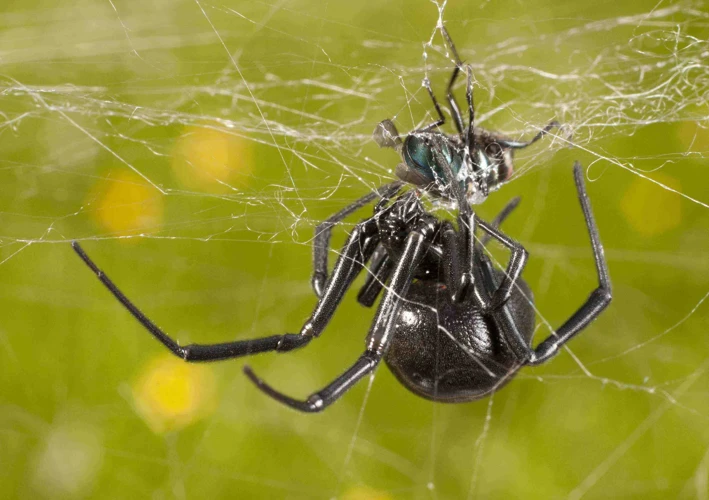Introduction
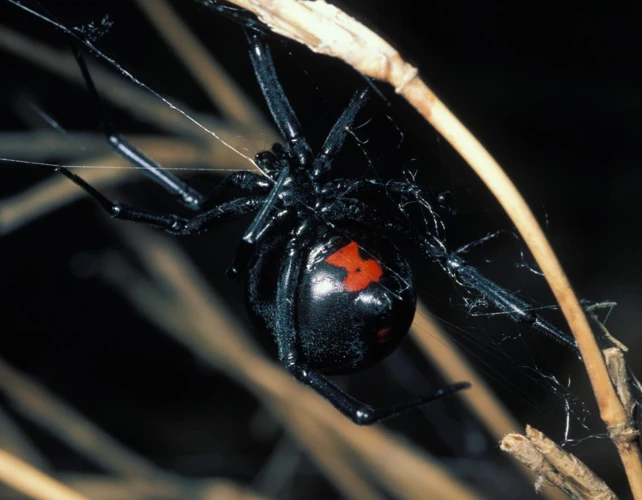
As we delve into the world of black widow spiders, it becomes evident that their feeding techniques are a fascinating subject worth exploring. These arachnids are infamous for their venomous bites and predatory behavior, which are vital to their survival. In this article, we will take a closer look at the feeding habits of black widow spiders, from their methods of catching prey to their consuming techniques and feeding frequency. It is essential to understand these creatures’ predatory behavior to appreciate their crucial role in the ecosystem and how they interact with their environment. Join us on this journey of discovery as we explore the fascinating world of black widow spiders.
Overview of Black Widow Spiders
Overview of Black Widow Spiders
Black widow spiders, scientifically known as Latrodectus, belong to the family Theridiidae. They are found all over the world, and there are 32 recognized species of black widow spiders. The most common species in North America is the Southern black widow (Latrodectus mactans), which is distinguished by a prominent red hourglass marking on its abdomen. These spiders can be found in dark, sheltered areas, such as outdoor sheds, woodpiles, and garages.
Black widow spiders are known for their distinctive appearance and the potent venom they possess. Male black widows are smaller and less venomous than females, but still have venom that can be harmful to humans. Although black widow spiders are fierce predators, they only bite humans in self-defense. In fact, their primary function is to hunt and kill prey, which they do using a variety of feeding techniques.
Feeding Behaviors
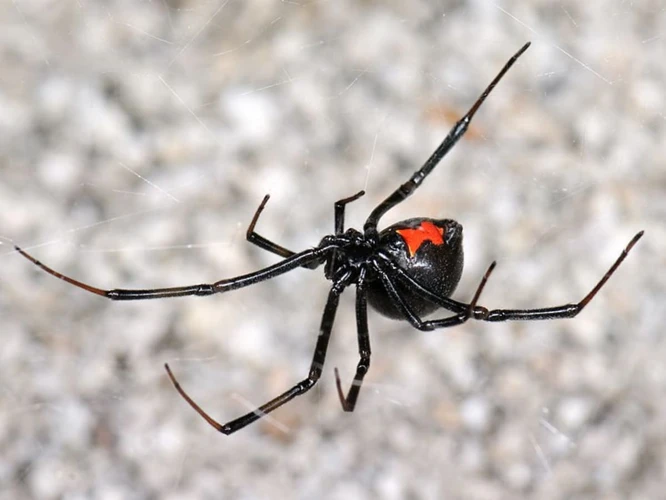
The feeding behaviors of black widow spiders are fascinating and gruesome, showcasing their ability to capture and consume prey efficiently. These predators have a unique approach to handling their prey, including various techniques for catching and consuming it. Understanding the feeding behaviors of black widow spiders is essential to grasp their role in the ecosystem, as well as the impact their feeding habits can have on prey items and other spiders. In this section, we will explore how black widow spiders catch and consume prey, and the different techniques they use to do so.
Catching Prey
Black widow spiders are skilled hunters that catch a wide variety of prey items. Their primary method of catching prey is by using their sticky webs, which they spin with great care and artistry. Once their prey is trapped in the web, black widow spiders immobilize it with their venomous bite before consuming it. It should be noted that black widow spiders have both positive and negative effects on their ecosystem. On the one hand, they help to control the populations of many insect species. On the other hand, black widow spiders can also be harmful to humans and other animals.
Some prey items commonly caught by black widow spiders include:
- Beetles
- Mosquitoes
- Moths
- Butterflies
- Ants
- Grasshoppers
- Crickets
- Spiders
- Scorpions
- Caterpillars
- Flies
- Other small insects
Black widow spiders have also been known to catch and consume small vertebrates, such as lizards and mice. These larger prey items are typically caught using ambush or active hunting techniques rather than through the use of webs. It is important to note that although black widow spiders are capable of catching and eating a wide variety of prey, they are not particularly fast or aggressive hunters. Instead, they tend to rely on their web-building skills and the toxic effects of their venom to capture and subdue their prey.
Black widow spiders are skilled hunters that use a combination of web-building, ambush, and active hunting techniques to catch a wide variety of prey items. While they play an important role in controlling insect populations, it is important to be aware of their potential to cause harm to humans and other animals. If you want to learn more about the feeding habits and behaviors of black widow spiders, check out our article on prey items commonly caught by black widow spiders.
Consuming Prey
Black widow spiders are known for their unique feeding techniques. After catching their prey, they inject them with venom and break down their bodies by releasing digestive enzymes. The resulting liquid is then consumed by the spider. This process is crucial for the spider’s survival, as it provides them with the necessary nutrients to thrive. Below are some interesting details about black widow spiders’ consuming prey process.
- Efficient consumption: Black widow spiders are highly efficient at consuming their prey. They leave nothing behind and consume even the smallest parts of their prey. This helps them to extract every possible nutrient from their prey.
- Small prey: They prefer to consume small prey, as these are easier to handle and digest. Large prey can be difficult to consume and require a significant amount of energy.
- Intoxication: When black widow spiders consume their prey, they become intoxicated by the venom. This can make them less responsive to their surroundings and more vulnerable to predators.
- Environment: Black widow spiders consuming process is affected by their environment. In warm environments, digestion occurs faster, while in cooler environments, it takes longer.
- Discarding the exoskeleton: Black widow spiders discard the exoskeleton of their prey, which is not digestible. This helps to prevent the build-up of indigestible material in their digestive tract.
- Overfeeding: Overfeeding black widow spiders can lead to negative consequences, such as obesity, decreased mobility and stress. This can impact their survival and overall health.
Black widow spiders’ consuming prey process is fascinating and unique. It highlights the spider’s ability to extract every possible nutrient from their prey, as well their adaptability to different environments. Understanding their consuming process is crucial to understanding their role in the food chain and their overall survival.
Hunting Techniques
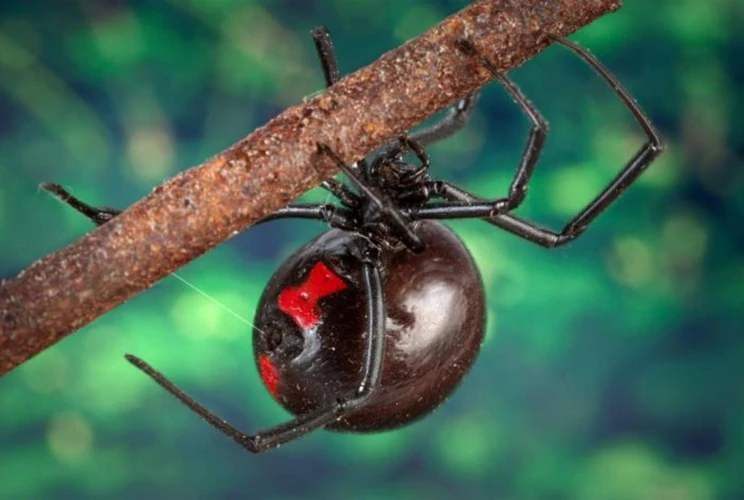
As one of the most fearsome predators in the arachnid world, Black Widow Spiders employ a range of hunting techniques that enable them to capture and consume their prey with ease. Whether it is through the use of webs, ambush tactics, or active hunting, these spiders have developed an arsenal of skills that makes them one of the top hunters in the food chain. In this section, we will explore the various techniques that these spiders use when stalking their prey. So, let’s delve deeper and discover the remarkable hunting skills of the Black Widow Spider. To learn more about the vulnerabilities of Black Widow Spiders, check out the male black widows that sometimes get eaten.
Webs
Black Widow Spiders use webs for catching their prey. These webs are made up of extremely strong and sticky silk. The spider spins the silk from its spinnerets to create different types of webs including sheet webs, cobwebs, and funnel webs. The webs are used by the spider to trap prey that happens to stumble across them.
The Sheet Webs are horizontal, flattened webs that are loosely woven. They are commonly found along the ground or on plants. The spider will hide nearby and wait for any unsuspecting prey, such as insects or small arachnids, to become entangled in the web.
The Cobwebs are chaotic looking webs seen near windows, under furniture, and in any other corner of the house. They are not used for catching prey, but as a retreat for the spider. When the spider is not hunting or mating, it retreats to a corner and waits for its next meal.
The Funnel Webs are used for both protection and hunting. The spider stays at the entrance of the funnel, which is made of silk. It then waits for its prey to come into contact with the web, and quickly subdues it with venom.
The venom of the Black Widow Spider is used to subdue prey. To catch its prey, the spider often creates intricately woven webs. These webs are also used by the spider for protection and as a retreat from harsh weather conditions. Black Widow Spiders can be beneficial to humans by controlling the populations of pests, but they can also become a nuisance when they invade homes and gardens. To learn more about Black Widow Spiders and their feeding behavior, check out our article on Black Widow Web Feeding Behavior.
Ambush
The Black Widow spider’s ambush technique is a great way to catch their prey without expending too much energy. This technique is often used by female spiders, who spin loose webs with a tangled look. These webs are constructed in secluded areas near their nests or in corners, where prey is likely to pass by. When a prey animal comes into contact with the web, the spider quickly immobilizes it with its venomous bite.
Unlike their active hunting method, their ambush technique doesn’t require spiders to actively hunt down their prey. Instead, they patiently wait for their prey to stumble into their trap, which could include a wide range of insects such as flies, mosquitoes, and beetles. Their web also captures small vertebrates and arachnids, such as lizards and other spiders.
It’s worth noting that Black Widow spiders don’t exclusively use their ambush technique. They also actively hunt down their prey, creating intricate webs that can capture larger creatures such as grasshoppers and crickets. However, this method requires more energy and the spider may have to travel long distances in search of prey. Ambush is the more energy-efficient method of feeding for Black widow spiders.
It’s fascinating to see how these spiders have developed such unique and intricate feeding techniques. To learn more about the Black Widow Spider’s feeding patterns, check out our article on Black Widow Spider’s Food Chain.
Active Hunting
Active hunting is a technique used by black widow spiders to catch their prey. Unlike catching prey through their webs or ambushing them, active hunting involves the spider moving around in search of its next meal.
To actively hunt, black widow spiders use their keen sense of vibration detection to locate potential prey. They can detect vibrations from as far away as 30 feet and are particularly sensitive to the vibrations of insects, which they can easily identify as a potential food source. Once a potential prey item has been detected, the black widow spider will approach it stealthily.
Black widow spiders are incredibly fast and agile hunters, capable of quickly catching their prey with ease. They stalk their prey before pouncing on them, using their strong legs to subdue it. These spiders are also incredibly patient, often waiting for hours or even days for their prey to come within striking distance.
Once the prey has been captured, the black widow spider will use its powerful venom to subdue it. The venom acts as a neurotoxin, quickly paralyzing the prey and making it easier to consume.
It’s important to note that while active hunting is an effective technique used by black widow spiders, it can also be risky. Prey items that are too large or aggressive can potentially injure or kill the spider, leaving it without a meal. Additionally, actively hunting requires energy, which means that a spider may burn more calories than it gains from successfully catching its prey.
Active hunting is just one of the many feeding techniques used by black widow spiders. By combining this technique with their web-building and ambushing skills, these spiders are able to successfully capture a wide variety of prey, making them formidable predators in the wild.
Venom and Subduing Prey
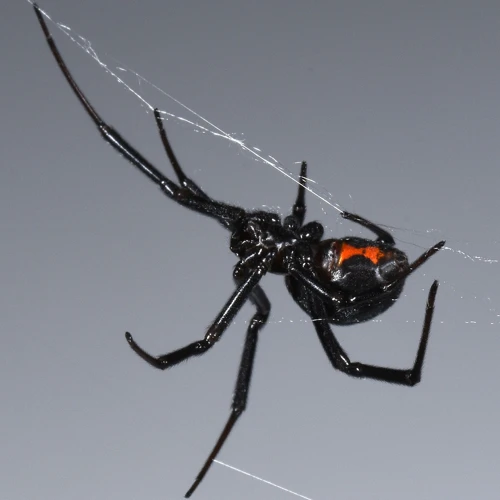
Although Black Widow Spiders are known for their venomous bites, the various types of venom they use to subdue their prey may come as a surprise. As one of the most lethal spiders in the world, the Black Widow Spider uses its powerful venom for hunting and self-defense. Understanding the types of venom Black Widow spiders use and how they work is crucial in comprehending the feeding behavior of this species. In this section, we will delve into the complicated and fascinating process of venom and subduing prey.
Types of Venom
Black widow spiders are known for their venomous bites that they use to subdue their prey. There are two main types of venom used by black widow spiders: neurotoxins and cytotoxins.
Neurotoxins: These types of venom affect the nervous system of the prey. They cause muscle spasms, paralysis, and can eventually lead to death. Black widow spiders mainly use this type of venom to subdue small insects. The venom acts quickly, making it difficult for the prey to escape.
Cytotoxins: These types of venom affect the cells of the prey. They can cause tissue damage and necrosis. Black widow spiders use this type of venom to subdue larger prey, including other spiders and even vertebrates such as lizards and birds. The venom takes longer to act but is effective in breaking down the larger prey.
It’s important to note that while black widow spider venom is dangerous to their prey, it is not typically lethal to humans. However, if bitten, it’s important to seek medical attention as the venom can cause severe pain and muscle spasms.
Internal link: Juvenile black widow spiders also use venom to subdue their prey, but as they grow and mature, their venom becomes more potent and effective.
How Venom Works
Black Widow spiders are perhaps most famous for their venomous bite and the serious health complications it can cause. Their venom contains a neurotoxin, which affects the nervous system of their prey. When a Black Widow spider bites, the venom enters the victim’s bloodstream and begins to attack the nervous system. The venom then paralyzes the prey, making it easier for the spider to subdue and consume the prey.
Typically, the Black Widow spider injects venom into its prey through its fangs. The venom is made up of various proteins, and the toxicity and components of the venom can vary depending on the particular species and the individual spider. Interestingly, while the venom of the Black Widow spider is incredibly potent, it doesn’t always immediately kill its prey. Instead, the venom can leave prey alive but paralyzed, allowing the spider to consume it at its leisure.
The venom of the Black Widow also affects humans differently, depending on various factors, such as the size and weight of the person and the amount of venom injected. In some cases, a bite can result in muscle cramps, spasms, and in extreme cases, difficulty breathing or death. If bitten, it is important to seek medical attention immediately.
The venom of the Black Widow spider is an incredibly powerful tool for subduing prey. It serves as a testament to the spider’s exceptional hunting abilities and has contributed to its success as a predator.
Types of Prey
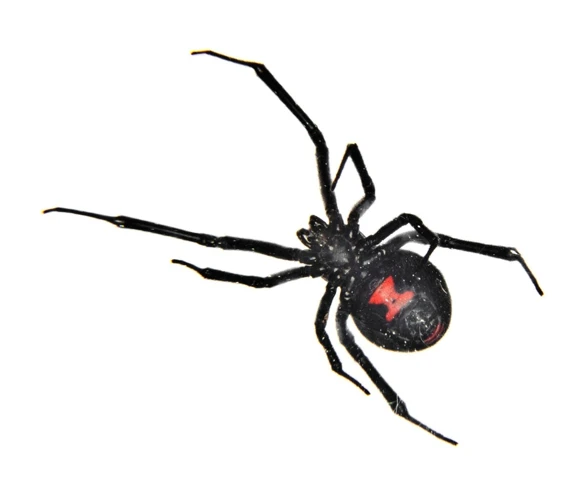
As opportunistic predators, Black Widow Spiders have a diverse range of prey that they can consume. Their diet mainly consists of insects, arachnids, and small vertebrates. However, the type of prey consumed may vary depending on the availability and accessibility of food sources in their habitat. In this section, we will take a closer look at the types of prey that Black Widow Spiders target in their feeding behaviors. Understanding their prey profile can give us valuable information about their hunting techniques and how they survive in their environment.
Insects
Black widow spiders are known to prey on many different types of insects, making them one of the most diverse predators in the animal kingdom. Some of the most common types of insects that black widow spiders feed on include crickets, beetles, grasshoppers, and flies. They have even been known to feed on much larger insects like locusts and other spiders.
One interesting thing about black widow spiders is their feeding habits, which often involve immobilizing their prey using their venom before consuming them. This is a key survival tactic that enables them to feed on insects that may be larger or stronger than they are. Once the prey is immobilized, the black widow spiders will proceed to feed on them, often for several hours.
It’s worth noting that black widow spiders are not picky eaters, and they will feed on any insects that they can catch. The spiders use their webs and hunting techniques to catch insects, then use their strong jaws to consume their meal.
Black widow spiders are also known for their tendency to overfeed, which can have serious consequences for their health. Overfeeding can cause obesity and other health-related issues, ultimately reducing the spider’s lifespan. In some cases, black widow spiders will even resort to cannibalism if they run out of food or are unable to find a mate.
Black widow spiders are formidable predators that feed on any insects they can catch. Their venom allows them to immobilize their prey before consuming, which is a key survival tactic. However, their tendency to overfeed and engage in cannibalism can have serious consequences for their health and well-being.
Arachnids
Arachnids are another common prey for Black Widow spiders. The most commonly consumed arachnids include scorpions, other spiders, mites, and ticks. Black Widow spiders are generally known to feed on a variety of arachnid species, but their feeding behavior may vary depending on the specific species of spider they are hunting.
Black Widow spiders use a variety of techniques to catch their arachnid prey. They may use their sticky webs to trap them, or they may actively hunt them down. Once caught, Black Widow spiders inject their venom to subdue their prey. The venom contains powerful toxins that can affect the nervous system and cause paralysis in the prey. The spider will then wrap its prey in silk and consume it at its leisure.
Interestingly, male Black Widow spiders are known to sacrifice themselves during mating, becoming food for the female after copulation. This cannibalistic behavior ensures that the female has enough food to produce her eggs. It’s also not uncommon for female Black Widow spiders to prey on their own male partners, especially if they are hungry or there is a lack of food available.
It’s essential to note that while Black Widow spiders are voracious hunters, they don’t necessarily need to feed often. In fact, they can go several weeks without food and still survive. Overfeeding can also be detrimental to their health, leading to obesity and other health problems.
| Common arachnid prey for Black Widow spiders: |
|---|
| 1. Scorpions |
| 2. Other spiders |
| 3. Mites |
| 4. Ticks |
Black Widow spiders are skilled hunters that use a variety of techniques to catch and consume their prey. While arachnids are a common target, they can also hunt insects and even small vertebrates. Their feeding habits vary depending on factors like the availability of food and their reproductive needs. To learn more about Black Widow spider feeding behavior, check out our article on feeding behavior in male and female Black Widow spiders.
Vertebrates
Black Widow Spiders are notorious for their feeding habits, and their prey primarily holds insects and arachnids. However, they are also known to prey on small vertebrates, such as lizards and frogs, although this is a rare occurrence.
The venom of Black Widow Spiders is neurotoxic, which is harmful to the nervous system of vertebrates, and can cause paralysis or even death. The venom helps subdue vertebrates, which can then be consumed by the spider. However, it is important to note that the amount of venom necessary to subdue a vertebrate is much greater than for insects or arachnids, and the risk posed by the vertebrates causes the spiders to avoid them whenever possible.
In fact, feeding on vertebrates is so rare for these spiders that researchers have only documented a few instances of Black Widows preying on them in the wild. One documented case involved a black widow spider consuming a small lizard.
While preying on vertebrates is a potential source of food for Black Widow Spiders, it is not an ideal food source and poses a significant risk to the spider. The spiders also require less food than vertebrates can provide, and overfeeding can lead to obesity and cause a range of health issues for the spiders.
While Black Widow Spiders are capable of preying on small vertebrates, they generally stick to easier prey such as insects and arachnids. It is essential to note that the risks associated with hunting vertebrates outweigh the potential benefits, and over-feeding can lead to health problems for the spiders.
Feeding Habits and Frequency
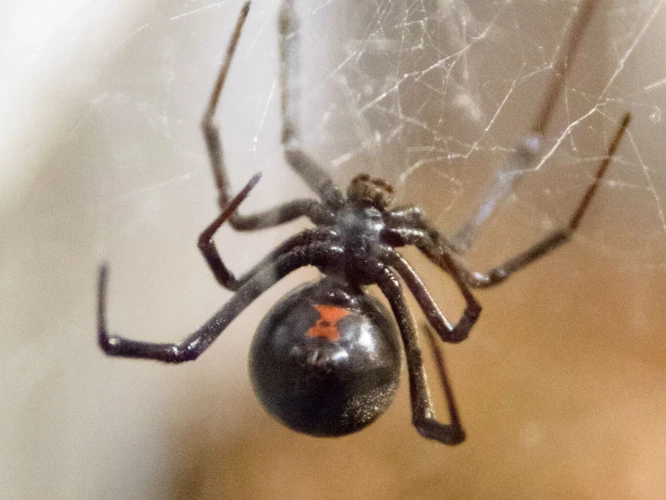
Feeding Habits and Frequency
Black widow spiders are known for their unique feeding habits. They are carnivorous, and their diet consists mainly of insects, arachnids, and occasionally even small vertebrates. As ambush hunters, black widows rely on their webs to catch prey. They also use their venom to subdue their prey before consuming them.
In terms of feeding frequency, black widows vary depending on the abundance of prey in their habitat. When prey is scarce, black widows can go for several weeks without food. However, if food is abundant, they may feed as often as every few days. It’s important to note that overfeeding a black widow can be harmful to their health, as they may become obese and unable to move or reproduce.
Another interesting feeding habit of black widows is their tendency to cannibalize, or eat their mates. This behavior has been observed in some species of black widow spiders, particularly when food is scarce. Cannibalism also occurs when females mistake their mates for prey or when the male’s primary goal is to be eaten after mating.
Black widows have unique feeding habits and frequency that are influenced by various factors such as prey availability and their mating behavior. As fascinating as they are, it’s important to respect their space and avoid overfeeding or interfering with their natural feeding habits. For more information on mating behavior, refer to the article on Black Widow Spiders Mating Habits, or for information on the effects of no food on black widows, check out Black Widow Spiders without Food: Effects on Health and Behavior.
Reproduction and Feeding
When it comes to reproduction and feeding, there are some interesting behaviors to unpack among Black Widow Spiders. The females, who are known for their iconic red hourglass shape on their abdomen, are the ones who typically consume prey. This is because females need protein-rich food to maintain their energy and develop eggs.
During mating, the males are at risk of being cannibalized by the females. Although not all males become prey, research has suggested that the smaller or weaker males are more likely to be eaten by their mate. This is likely due to the fact that the female needs to consume nutrients to support her developing eggs.
Interestingly, female Black Widow Spiders can store sperm for long periods of time. This means that they can produce multiple clutches of eggs without needing to mate again. It’s possible that this strategy helps to reduce the risk of male cannibalism during mating, but it’s not entirely clear.
Overfeeding female Black Widow Spiders can actually lead to negative outcomes in terms of reproduction. This may seem counterintuitive, but research has shown that overfed females may produce fewer eggs or lower quality eggs. This is thought to be due to the fact that an overabundance of food can throw off the balance of hormones and disrupt the reproductive process.
The relationship between reproduction and feeding in Black Widow Spiders is complex and fascinating. While females require a protein-rich diet to support their developing eggs, overfeeding can have negative consequences. Additionally, males risk being cannibalized during mating, which may shape the mating strategies of both males and females.
Conclusion
In conclusion, the feeding techniques used by black widow spiders are fascinating and unique. With their venomous bite and hunting strategies, black widows are able to capture a wide variety of prey, including insects, arachnids, and even small vertebrates. Their feeding habits and frequency vary depending on environmental factors such as temperature and prey availability. When it comes to reproduction and feeding, female black widows have been known to practice cannibalism, which ensures that the strongest offspring survive.
It’s important to note that while black widow spiders are successful predators, overfeeding them can actually be detrimental to their health. In fact, overfeeding can lead to obesity and decreased lifespan in black widow spiders. To maintain a healthy diet for your pet black widow, it’s important to understand their natural feeding habits and provide them with an appropriate amount of prey.
Overall, the feeding techniques used by black widow spiders are a fascinating aspect of their biology and behavior. By understanding how they catch and consume prey, we can gain a deeper appreciation for these amazing creatures.
Frequently Asked Questions
How do Black Widow Spiders catch their prey?
Black Widow Spiders use their sticky webs to trap their prey. They can also hunt actively by stalking and pouncing on their prey.
What do Black Widow Spiders typically eat?
Black Widow Spiders feed mainly on insects such as flies, grasshoppers, and beetles. They also eat other spiders and even small vertebrates like lizards and mice.
How does a Black Widow Spider consume its prey?
Black Widow Spiders inject their prey with digestive enzymes using their venomous fangs. Once the prey is liquefied, the spider drinks it up.
What are the different hunting techniques used by Black Widow Spiders?
Black Widow Spiders use a variety of hunting techniques, including building webs to catch prey, ambushing prey from hiding places, and actively pursuing their prey.
What types of venom do Black Widow Spiders have?
Black Widow Spiders have two types of venom: a neurotoxin that affects the nervous system, and a cytotoxin that destroys cells.
How does Black Widow Spider venom work?
Black Widow Spider venom works by disabling the prey’s nervous system, causing paralysis and muscle spasms. The cytotoxin also destroys cells, making it easier for the spider to consume its prey.
What types of prey do Black Widow Spiders typically eat?
Black Widow Spiders mainly eat insects like flies, grasshoppers, and beetles. They also eat other spiders and small vertebrates like lizards and mice.
How often do Black Widow Spiders need to feed?
Black Widow Spiders can go without food for several weeks, but they typically feed once a week or more.
Do Black Widow Spiders eat their mates?
While it is a common misconception that female Black Widow Spiders always eat their mates after mating, this behavior is actually relatively rare. It is more likely to happen when the female is hungry and the mate is small.
Are Black Widow Spiders dangerous to humans?
Black Widow Spiders can be dangerous to humans, as their venom can cause symptoms like muscle spasms, nausea, and difficulty breathing. However, they are usually not aggressive and will only bite if they feel threatened.

